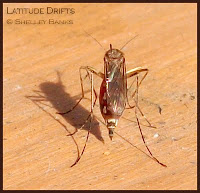 |
| Aedes vexans feasting on tasty human flesh. Regina, SK © SB |
I can't read Latin (only English, Spanish, French). But the dictionary confirms 'vexans' is the present participle of 'vexare', aka troubling. And Aedes, as far as I can figure, is fake Latin or old Greek for 'pleasant... not!"*
I'm also no entomologist, but the Saskatoon Star Phoenix says that vicious Aedes vexans are what's vexing us right now. And a 2004 report from Saskatchewan Health for the Canadian Cooperative Wildlife Health Centre confirms that Ae. vexans is Saskatchewan's "most common mosquito pest for humans."
 |
| Bloated bug, to full to fly. © SB |
The bad news? This year, there are more Ae. vexans than ever; as the local radio reports: "Mosquito numbers in Regina exceed 10-year average." The even worse news? This insect is known as "a fierce and painful biter."
Aedes vexans are "most easily recognized by the sideways 'B' shaped markings on each abdominal tergite," says Bugguide.net.
I've never heard of 'tergites' before, but our backyard/front porch/alley pests certainly feature narrow rings of white scales down their backs. And they are ever-present, And vicious.
Earlier this week, I set up my observation post (aka lounge chair, beer and camera) on the patio, prepared to serve as bait to catch a few pixels of mosquitoes. Several stealth-struck Gord, but none landed on me. As Robert Anderson explains in "Manitoba: a colour guidebook":
Some people have all the luck and are more attractive to mosquitoes than others. In fact, a good way to minimize your contribution to the next mosquito generation is to go for a walk with one of these lucky individuals and let him provide the smorgasbord.And so, many thanks to my very attractive companion for luring the Aedes vexans pictured here to land on his skin, and feast on his blood.
 |
| You can tell this Ae is female because she`s well fed on blood — and has that long proboscis. © SB |
~~~~~
Seems strange to me, but I am told that some people find my fascination with mosquitoes to be weird — even weirder that I actually learn and remember some of their names. But naming is important. The more precise our language, the richer and more distinct our worlds.
And mosquitoes are not all alike. As the Canadian Geographic travel club blog says, Know Thine Enemy:
All mosquitoes are not created equal. Some species are extremely aggressive and annoying, others less so. Aedes vexans, for example, is a small, in-your-face mosquito that comes out a week after a heavy rainfall, day or night. Other species, such as Culex tarsalis, are less aggressive. Sneaky but easily disturbed when biting, C. tarsalis will attack your ankles and the backs of your arms when you're not looking. Other species bite only later in the evening and at night, and you don't notice you've been bitten — until you wake up scratching.
~~~~~
The first mosquito I learned to name was Aedes aegypti, the yellow-fever mosquito, a species once-eradicated in the Cayman Islands that surfaced again with a vengeance the year I left for university. The local Mosquito Research and Control Unit launched an all-out attack, surveying houses and fogging the streets.
That wasn`t my first experiences with spraying against mosquitoes. One consistent memory I have of evenings in Grand Cayman, where I lived as a teenager, is of fogging machines (mounted on Mini Mokes often driven by volunteers, for those looking for full visuals), rolling through the streets of Georgetown at dusk and beyond, filling the air with the gray smelly haze of malathion diluted in diesel oil
And by morning, as the Cayman Islands government webpage says of these MRCU assaults: "Windrows of dead mosquitoes were reported in the streets."
 |
| Here's looking at you, kid. (All close-ups are of the Ae. vexans at right in top skin shot.) © SB |
~~~~~
And yes, I know:
- Wear DEET, long sleeves.
- Drain standing water.
- Buy another goldfish for our pond.
~~~~~

No comments:
Post a Comment